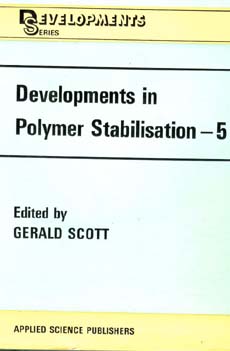
The purpose of the present series of publications is two-fold. In the first place it is intended to review progress in the development of practical stabilising systems for a wide range of polymers and applications. A complementary and ultimately more important objective is to accommodate these practical developments within the framework of antioxidant theory, since there can be little question that further major advances in the practice of stabilisation technology will only be possible on the basis of a firm mechanistic foundation.
A frequently observed phenomenon in the study of antioxidants in polymers is the existence of critical concentration limits within which they show predictable concentration dependent activity and outside of which they show discontinuity. A growing understanding of the factors determining antioxidant activity in polymers has made possible a kinetic approach to this problem and the important contribution made by Shlyapnikov and his co-workers in this area is reviewed by the author in Chapter 1. The micro-environment within the polymer, and in particular the solubility and rate of diffusion of oxygen, is shown to control the performance of antioxidants in polymer matrices by Denisov in Chapter 2. In particular the importance of alkyl radical trapping which results from limited oxygen diffusion is outlined. A specific and currently very important example of antioxidant action, alkyl radical trapping by nitroxyl radicals, is critically discussed by Shlyapintokh and Ivanov in Chapter 3 on the basis of their own and other published work.
In recent years, the potential importance of polymers with limited but reproducible lifetime has been recognised and has been the object of research in both academic and industrial laboratories. An important
industrial outcome of this research, the commercial development of controlled-life protective films and fibres for agricultural use, is described by Gilead and Scott in Chapter 4.
The performance of polymers in the fire environment remains a major cause of social and hence scientific concern. Considerable progress has been made towards empirical solutions to this problem and this has been reviewed in the technological literature. However, the scientific understanding of the mechanistic basis of the activity of flame retardants is still fairly rudimentary. The current position is critically reviewed by Hirschler in Chapter 5 and in Chapter 6 Tkac describes a novel and potentially very important experimental approach to the ESR study of the chemical processes involved in the function of flame retardants.
GERALD SCOTT
CONTENTS
Preface. . . •.......' • v
List of Contributors.........ix
1. Critical Antioxidant Concentration Phenomena and their Application .......... 1
Yu. A. SHLYAPNIKOV
2. Role of Alkyl Radical Reactions in Polymer Oxidation and Stabilisation .......... 23
E. T. DENISOV
3. Antioxidant Action of Sterically Hindered Amines and Related Compounds .......... 41
V. YA. SHLYAPINTOKH and V. B. IVANOV
4. Time-controlled Stabilisation of Polymers . . . .71
D. GILEAD and G. SCOTT
5. Flame Retardant Mechanisms: Recent Developments . .107
M. M. HIRSCHLER
6. A Study of Flame Retardant Mechanisms by ESR . . .153
A. TKAC
Index .... ......233